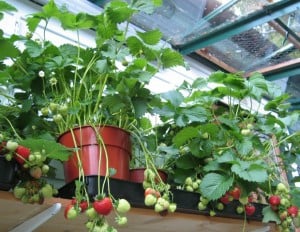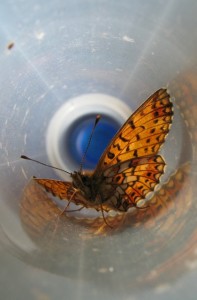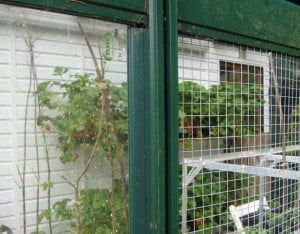Earth-friendly plant protection is a finely judged art, but with a little ingenuity you can thwart the pests while providing safe passage for pollinators.
Now it begins. Yellow daggers wait poised and patient at the doors. Sharp claws wrench blood-curdling screeches from the glass. Sets of vicious, hazelnut-honed incisors pluck and twang at the wire mesh. Black, bottomless eyes look on. Yes, I know it sounds like something from a horror story, but it’s not; it’s just another summer’s day around my greenhouse – when wild things of all shapes, sizes and persuasions start to see red.

The ‘red’ that the blackbirds, squirrels and ravens crave is my potted strawberries. Grown peat-free, and without heat (other than renewable modern sunshine), pesticides or tap water, I now have berries in every shade from hard, bitter green through to saliva-inducing scarlet; enough ripening every few days for a good bowlful. I once thought – naively as it turned out – that nothing would cast eye, beak or incisor at hard, green unripe strawberries; I’d only have to net them at the first pink flush. The squirrels were having none of it. Once they’d galvanised their tastebuds, green berries were mere marshmallows; they sat defiantly, chomping away. I shooed them off; they came back in ten minutes. I covered the fruits with plastic netting; the squirrels took half an hour to work out that they only had to bite a hole through it, and carry on. I bellowed blue murder, put the holed netting away, raised the tattered, juice-stained flag, and surrendered.
Nowadays my strawberries grow in splendour in my greenhouse. They live in big pots which come indoors in mid-winter and are coaxed on by the greenhouse’s shelter, and by its ahead-of-the-outdoors warming. But one slip, one moment of forgetfulness, one blind eye (‘I’ll just make some tea’), and all hell breaks loose. If there’s one thing worse than a hungry squirrel tearing at the chicken mesh barriers now fitted in the roof vents, it’s a cornered, red-lipped squirrel thrashing terror-stricken through the tomatoes.
Outfoxing my wild neighbours has come at a price: as soon as anything which looks like a strawberry appears, I can’t risk having the greenhouse doors open for more than a few untended minutes. So I dust off the wire mesh frames I made, hook them over the doors and jam them tight shut at the base with chunks of slate. It’s the only way I can have the doors fully open to get maximum ventilation. Or at least that’s what I do when I’m going out. If I’m on the ‘in’ side of the mesh, I keep an anxious ear cocked for the now-familiar cussing of a squirrel thwarted yet undeterred, as it skitters around the frame, looking for a gap.

Going out is one thing, going away is quite another. My fortified greenhouse and the fate of my fruits are then left in the care of my neighbours or cottage-sitters, who must observe – diligently – all of the security protocols. Bar a few near misses, all is usually well, but I know that – like all gardeners – they probably won’t check if there’s still a gap on the right-hand side of the main door about two-thirds of the way down… In fairness, it’s not much fun grappling with the door barriers in a North Walian downpour with the greenhouse gutter emptying straight down your neck, and midges biting at your heels (or at any other speck of exposed flesh). If only I could wave a magic wand and swap the glass in the doors for incisor-resistant wire mesh.
Wands are in short supply here so, trying nous instead, I sussed out that the glass is only held in place by glazing strips. Even a DIY dimwit like me was able to remove the strips, take out the glazing, cut rigid mesh panels to the same size as the glass and fit them in its place (taking photos is a useful reminder of how things go back together). So, with the doors fully closed and my fellow species left looking on with envious eyes, I get maximum ventilation – but with no need to keep looking over my shoulder, no more cumbersome mesh panels, and no more ‘does he really mean it?’ from drill-weary strawberry sitters. Fortification now complete, the fruits are safe. When security winds down and temperatures fall, the glazing will go back in.
This triumph over yellow daggers, vicious incisors and beady black eyes belies the fact that there’s remarkably little that I actually want to exclude from my greenhouse (it’s mostly the ‘big stuff’). Without hoverflies backing up my hit-and-miss spring efforts with a paintbrush, far fewer of the strawberry flowers would have got pollinated, meaning fewer fruits. Even now the hoverflies are busy laying their eggs amongst odd colonies of aphids on all my crops, while tiny parasitoid wasps are injecting them with their own lethal eggs. Even the midges are earning their keep by fattening the greenhouse’s resident spider population. But there are other natural neighbours that have come up trumps since I ditched my dim-wittedness: bees and butterflies.

One of the sad frustrations of owning a greenhouse is that it inevitably causes some collateral damage. Some allies, like hoverflies, have a knack of dipping and diving in and out of the doors and vents as they wish, attracted as they are in summer by flowers such as tagetes, which nestle among my tomatoes. They tend to fly low and get on with their business. Others, such as bumblebees, tend to… well, just bumble their way in, or get blown off course by a breeze. Although bumblebees do a grand job of pollinating strawberries, tomatoes and other crops, they’re a bit dim when it’s time to exit the greenhouse; they mostly head up, and get trapped, buzzing wildly against the glass, unless they just happen to head for a roof vent. If I don’t rescue them with my ‘bug hoover’, they soon get exhausted on a hot, sunny day. Butterflies have bumbling down to a fine art; I’m constantly sucking up anything from large cabbage whites to fritillaries. Or rather I was.
Now the doors have been turned into big, mesh-covered seasonal vents, the number of bumblebees and butterflies becoming caught up under glass has plummeted – as have SOS dashes to rescue them. I still need to hoover up a flurry of smaller insects each day, such as solitary bees and wood wasps, that aim high and then rail against the glass, and there are still a few casualties. Finer mesh would reduce the number further, but I don’t want to keep the small stuff out completely; it’s all part of a healthy, balanced greenhouse.
I’m cock-a-hoop. Thwarted, those covetous bills, claws and razor-like teeth will still only see red, but I’ve made my greenhouse a bit more nature-friendly to boot – and I’m seeing green.
Text and images © John Walker
Find John on Twitter @earthFgardener


